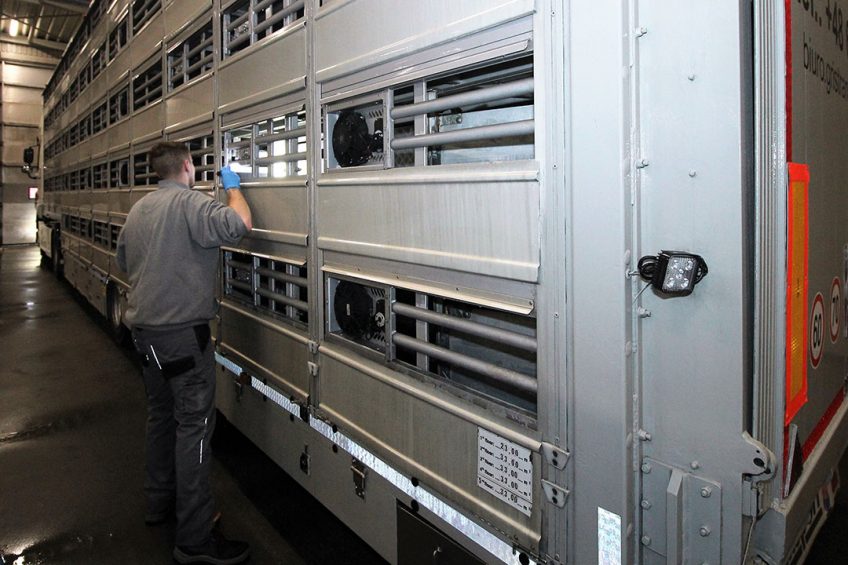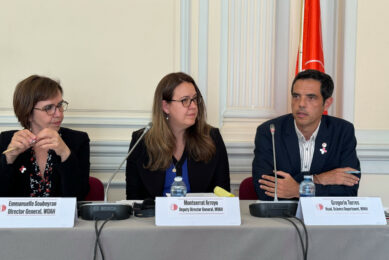Keeping ASF at bay at the Danish border

One way to successfully fight African Swine Fever is to make sure that the virus never enters a country. Denmark is keen to keep its doors closed to the virus – it upgraded the compulsory border cleaning and disinfection procedure for trucks and also constructed a fence.
A large empty Polish pig truck with three floors enters the ‘Danish’ washing station. Immediately the truck is attended to and the windscreen is properly covered in soap. “That is where most of the dirt is going, so it needs some additional attention,” explains Claus Clausen, director of Danish Safety Wash in Padborg, southern Denmark at the border with Germany, right at the motorway.
Very soon after, a moveable construction on rails moves slowly from front to back and front again to high pressure clean the entire lorry. After 15 minutes of washing the truck moves forward and drives through a porch spraying the disinfectant Vanadox on top of the truck.
Denmark is the only country with a policy like this, to clean trucks at the border. About 5 years ago, tiny bits of dirt were not so much of a problem… Things have changed now with African Swine Fever, at the moment the industry has a zero-tolerance policy.” – Claus Clausen
Obligation to properly wash
As Denmark is mostly an exporting pig country, many trucks leave Denmark full of piglets, and will come back empty. To avoid the introduction of pathogens into the Danish herd, each truck is obliged to be properly washed and disinfected before moving on – a programme paid for by the Danish pig producers themselves.

Danish Safety Wash is one of the 2 commercial companies in Padborg having a contract with SEGES, the Danish cooperative pig research organisation. SEGES is the owner of the Danish Transport Standard scheme, and the washing and disinfection stations have to ensure that they fulfil the requirements of this standard. Together they check each incoming livestock truck – and once approved they get an obligatory certificate. The rules are crystal clear: no pigs can be picked up in Denmark without the certificate.
The introduction of African Swine Fever into Eastern Europe has changed the way of working of Danish Safety Wash quite a bit, explains Clausen. Some trucks indeed come from areas where African Swine Fever (ASF) has broken out or has even become endemic, like in Middle and Eastern Europe. Inside the washing station’s control cabins, therefore a map of Europe is hanging, subdividing the continent into:
- green zones (no ASF),
- red zones (risk areas) and
- black zones (ASF present),
These determine which type of treatment a truck will get.
All trucks are equipped with GPS, so for the washing station it is relatively easy to trace in detail which zones the trucks had been prior to coming to Denmark. In case GPS fails to pass on data, the truck will automatically be treated like a ‘black zone’ truck.
Second phase of the treatment
Back to the Polish truck, which has now reached the hind part of the washing station and that means it is time for the second phase of the treatment. For about 25 minutes the truck will be disinfected while an employee of the Danish Safety Wash is going through the inside of the truck using a torch. Fairly soon he stops for a bit, scrutinises the situation and points to a place inside the truck. He is critical – every particle of dirt can mean that the truck is not clean enough and that means that the truck will have to be sent back into Germany.

Clausen explains, “Denmark is the only country with a policy like this, to clean trucks at the border. About 5 years ago, tiny bits of dirt were not so much of a problem. We could deal with it ourselves here, that was easiest and would save time. Things have changed now with African Swine Fever, at the moment the industry has a zero-tolerance policy.”
Once the drivers are back in Germany, they can choose how to solve the problem themselves, Clausen explains. The nearest truck wash in Germany is about 18km south, near Flensburg. Usually it takes them roughly 2 to 3 hours before they have cleaned what they needed to clean. Clausen says, “That is a bit of service we can do. We will clearly tell them what is the problem, so they know how to get through the next time.”
For trucks coming from the north, from Norway or Sweden, as well as from the ferry from Germany, a similar approach is used. They need to report to an island south of Copenhagen. The only exception is made for breeding pigs coming from Norway on their way to the continent. They will not stop inside Denmark and can therefore continue driving without washing and disinfection.
Third phase for disinfection
If the inspection is all OK, the third phase follows, which basically includes a ten-minute wait to allow the disinfectant to do its work. Clausen says: “Otherwise rain might rinse the substance off. The drivers in the meantime can have another cup of coffee.”
On the basis of their route prior to coming to Denmark, the trucks can receive four types of certificates after a successful cleaning and disinfection. The explanation on the certificate comes in Danish, English, German and Polish.
- Green corresponds to the map and means that the truck can enter the farm’s premises;
- Yellow means that the truck has been given one extra round of cleaning inside with soap and can enter a farm after 12 hours of quarantine;
- Red means that the truck can enter farms after 48 hours of quarantine – and the colour corresponds with the red on the ASF map – or that pigs can be picked up from a collection station;
- Black also corresponds with the ASF map and means that a seven-day quarantine period is necessary – or that pigs have to be picked up from a collection station.
When all is all right, the driver also receives a sealed bag with coverall and boot covers. For the pig producer who will be visited, the sealed bag will be a reassurance that the driver indeed was checked and approved at the border.
The Polish lorry is not that far yet. The Danish Safety Wash employee indeed does find a few remains of manure and dirt both inside the truck as well as behind the shutters on the outside. He clearly shows to the drivers what needs to be done before the truck can move on. The Polish drivers nod and understand. What awaits them first is a drive back into Germany and fix the problem first.
Fence to keep ASF outApart from having a stringent border control for livestock lorries, the Danish government also invested in having a 70km long fence, to protect the Denmark from (infected) wild boar entering from Germany. Early December, the Danish authorities announced that the fence had been completed.  The fence to keep out wild boar was completed early December. Photo: Vincent ter Beek The construction project, which lasted for roughly 10 months, cost eventually € 6 million. According to the Danish authorities, there are roughly 20 ‘gates’ to allow traffic and waterways to function. There, wild boar are being kept at bay using odour signals. In addition, for hikers there are doors in the fence. It is estimated that the only wild boar in Denmark are currently in the south – the population is estimated to be around 30-40 animals. The fence itself has not been applauded by all locals, as protest signs are visible at various locations. |
Dead wild boar washing ashore in DenmarkThe question of how to keep Denmark free from ASF got a different dimension in October 2019 and early November when eventually 12 dead wild boar of unknown origin washed ashore on the southern Danish island of Ærø. In this case, the authorities disposed of the animals at the Danish rendering company Daka, without checking for the virus. Dr Stig Mellergaard, DVM, chief advisor at the Danish Ministry of Environment and Food, explained to Pig Progress why this procedure was followed. He said, “We test all dead and shot wild boar from Denmark (where we know the origin) in order to document that Denmark is free from ASF. However, testing of animals of unknown origin, has only academic interest and if the result of such a test, unexpectedly, should be positive for ASF, Denmark would have to report it to the OIE and it will be regarded as a Danish case. It will be very difficult to explain to the world that it, basically, is not a Danish case but reflects another country’s problem.”  One of the dead wild boar washing ashore at Ærø. Photo: Ministry of Environment and Food, Denmark New cases washing ashore will therefore be treated in a similar way, Dr Mellergaard said, as the animals are unlikely to be Danish. “Therefore, we have no intention of changing the procedure even if a number of animals would wash in at a later occasion.” The animals were found at different locations on the coast of the island Ærø, where it is not common that carcasses of wild boar wash ashore. In a presentation to the European Commission’s Standing Committee on Plants, Animals, Food and Feed (Scopaff), Dr Mellergaard said: “The herd may have visited a small island along the German or Polish coast and have been caught by the current and drowned. Or may have fled to the sea during hunting activities.” |











